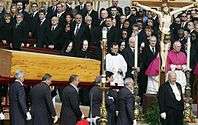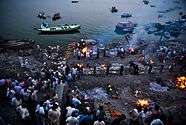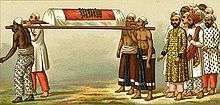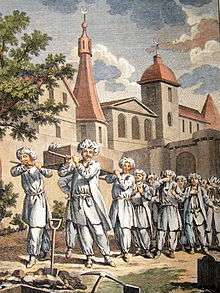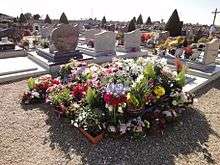Funeral
A funeral is a ceremony connected with the burial, cremation, or interment of a corpse, or the burial (or equivalent) with the attendant observances.[1] Funerary customs comprise the complex of beliefs and practices used by a culture to remember and respect the dead, from interment, to various monuments, prayers, and rituals undertaken in their honor. Customs vary between cultures and religious groups. Common secular motivations for funerals include mourning the deceased, celebrating their life, and offering support and sympathy to the bereaved; additionally, funerals may have religious aspects that are intended to help the soul of the deceased reach the afterlife, resurrection or reincarnation.
The funeral usually includes a ritual through which the corpse receives a final dispositon.[2] Depending on culture and religion, these can involve either the destruction of the body (for example, by cremation or sky burial) or its preservation (for example, by mummification or interment). Differing beliefs about cleanliness and the relationship between body and soul are reflected in funerary practices. A memorial service or celebration of life is a funerary ceremony that is performed without the remains of the deceased person.[3]
The word funeral comes from the Latin funus, which had a variety of meanings, including the corpse and the funerary rites themselves. Funerary art is art produced in connection with burials, including many kinds of tombs, and objects specially made for burial like flowers with a corpse.
Overview
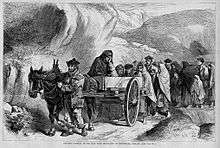
Funeral rites are as old as human culture itself, pre-dating modern Homo sapiens and dated to at least 300,000 years ago.[4] For example, in the Shanidar Cave in Iraq, in Pontnewydd Cave in Wales and at other sites across Europe and the Near East,[4] archaeologists have discovered Neanderthal skeletons with a characteristic layer of flower pollen. This deliberate burial and reverence given to the dead has been interpreted as suggesting that Neanderthals had religious beliefs,[4] although the evidence is not unequivocal – while the dead were apparently buried deliberately, burrowing rodents could have introduced the flowers.[5]
Substantial cross-cultural and historical research document funeral customs as a highly predictable, stable force in communities.[6][7] Funeral customs tend to be characterized by five "anchors": significant symbols, gathered community, ritual action, cultural heritage, and transition of the dead body (corpse).[2]
Religious funerals
Bahá'í
Funerals in the Bahá'í Faith are characterized by not embalming, a prohibition against cremation, using a chrysolite or hardwood casket, wrapping the body in silk or cotton, burial not farther than an hour (including flights) from the place of death, and placing a ring on the deceased's finger stating, "I came forth from God, and return unto Him, detached from all save Him, holding fast to His Name, the Merciful, the Compassionate." The Bahá'í funeral service also contains the only prayer that's permitted to be read as a group - congregational prayer, although most of the prayer is read by one person in the gathering. The Bahá'í decedent often controls some aspects of the Bahá'í funeral service, since leaving a will and testament is a requirement for Bahá'ís. Since there is no Bahá'í clergy, services are usually conducted under the guise, or with the assistance of, a Local Spiritual Assembly.[8]
Buddhist
A Buddhist funeral marks the transition from one life to the next for the deceased. It also reminds the living of their own mortality.
Christian
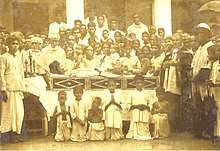
Christian burials typically occur on consecrated ground. Burial, rather than a destructive process such as cremation, was the traditional practice amongst Christians, because of the belief in the resurrection of the body. Cremations later came into widespread use, although some denominations forbid them. The US Conference of Catholic Bishops said "The Church earnestly recommends that the pious custom of burying the bodies of the deceased be observed; nevertheless, the Church does not prohibit cremation unless it was chosen for reasons contrary to Christian doctrine" (canon 1176.3).[9]
Congregations of varied denominations perform different ceremonies, but most involve offering prayers, scripture reading from the Bible, a sermon, homily, or eulogy, and music.[2][10] One issue of concern as the 21st century began was with the use of secular music at Christian funerals, a custom generally forbidden by the Roman Catholic Church.[11]
Hindu
Antyesti, literally "last rites or last sacrifice", refers to the rite-of-passage rituals associated with a funeral in Hinduism.[12] It is sometimes referred to as Antima Samskaram, Antya-kriya, Anvarohanyya, or Vahni Sanskara.
A dead adult Hindu is cremated, while a dead child is typically buried.[13][14] The rite of passage is said to be performed in harmony with the sacred premise that the microcosm of all living beings is a reflection of a macrocosm of the universe.[15] The soul (Atman, Brahman) is believed to be the immortal essence that is released at the Antyeshti ritual, but both the body and the universe are vehicles and transitory in various schools of Hinduism. They consist of five elements: air, water, fire, earth and space.[15] The last rite of passage returns the body to the five elements and origins.[13][15] The roots of this belief are found in the Vedas, for example in the hymns of Rigveda in section 10.16, as follows,
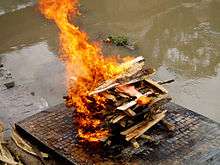
Burn him not up, nor quite consume him, Agni: let not his body or his skin be scattered,
O all possessing Fire, when thou hast matured him, then send him on his way unto the Fathers.
When thou hast made him ready, all possessing Fire, then do thou give him over to the Fathers,
When he attains unto the life that waits him, he shall become subject to the will of gods.
The Sun receive thine eye, the Wind thy Prana (life-principle, breathe); go, as thy merit is, to earth or heaven.
Go, if it be thy lot, unto the waters; go, make thine home in plants with all thy members.— Rigveda 10.16[16]
The final rites of a burial, in case of untimely death of a child, is rooted in Rig Veda's section 10.18, where the hymns mourn the death of the child, praying to deity Mrityu to "neither harm our girls nor our boys", and pleads the earth to cover, protect the deceased child as a soft wool.[17]
Among Hindus, the dead body is usually cremated within a day of death. The body is washed, wrapped in white cloth for a man or a widow, red for a married woman,[14] the two toes tied together with a string, a Tilak (red mark) placed on the forehead.[13] The dead adult's body is carried to the cremation ground near a river or water, by family and friends, and placed on a pyre with feet facing south.[14] The eldest son, or a male mourner, or a priest then bathes before leading the cremation ceremonial function.[13][18] He circumambulates the dry wood pyre with the body, says a eulogy or recites a hymn in some cases, places sesame seed in the dead person's mouth, sprinkles the body and the pyre with ghee (clarified butter), then draws three lines signifying Yama (deity of the dead), Kala (time, deity of cremation) and the dead.[13] The pyre is then set ablaze, while the mourners mourn. The ash from the cremation is consecrated to the nearest river or sea.[18] After the cremation, a period of mourning is observed for 10 to 12 days after which the immediate male relatives or the sons of the deceased shave their head, trim their nails, recites prayers with the help of priest or Brahmin and invite all relatives, kins, friends and neighbours to eat a simple meal together in remembrance of the deceased. This day, in some communities, also marks a day when the poor and needy are offered food in memory of the dead.[19]
Islamic
Funerals in Islam (called Janazah in Arabic) follow fairly specific rites. In all cases, however, sharia (Islamic religious law) calls for burial of the body, preceded by a simple ritual involving bathing and shrouding the body, followed by salat (prayer).
Burial rituals should normally take place as soon as possible and include:
- Bathing the dead body with water, camphor and leaves of ziziphus lotus,[20] except in extraordinary circumstances as in the Battle.[21]
- Enshrouding the dead body in a white cotton or linen cloth except extraordinary cases such as battle. In such cases apparel of corpse is not changed.[22]
- Reciting the funeral prayer in all cases for a Muslim.
- Burial of the dead body in a grave in all cases for a Muslim.
- Positioning the deceased so that when the face or body is turned to the right side it faces Mecca.
The mourning period is 40 days long.[23]
Jewish
In Judaism, funerals follow fairly specific rites, though they are subject to variation in custom. Funerals in Judaism share many features with those of Islam. Jewish religious law (Halakha) calls for preparatory rituals involving bathing and shrouding the body accompanied by prayers and readings from the Hebrew Bible, and then a funeral service marked by eulogies and brief prayers, and then the lowering of the body into the grave and the filling of the grave. Traditional law and practice forbid cremation of the body; the Reform Jewish movement generally discourages cremation but does not outright forbid it.[24][25]
Burial rites should normally take place as soon as possible and include:
- Bathing the dead body.
- Enshrouding the dead body. Men are shrouded with a kittel and then (outside the Land of Israel) with a tallit (shawl), while women are shrouded in a plain white cloth.
- Keeping watch over the dead body.
- Funeral service, including eulogies and brief prayers.
- Burial of the dead body in a grave.[24]
- Filling of the grave, traditionally done by family members and other participants at the funeral.
- In many communities, the deceased is positioned so that the feet face the Temple Mount in Jerusalem (in anticipation that the deceased will be facing the reconstructed Third Temple when the messiah arrives and resurrects the dead).[26]
Sikh
In Sikhism death is not considered a natural process, an event that has absolute certainty and only happens as a direct result of God's Will or Hukam. To a Sikh, birth and death are closely associated, because they are both part of the cycle of human life of "coming and going" ( ਆਵਣੁ ਜਾਣਾ, Aana Jaana) which is seen as transient stage towards Liberation ( ਮੋਖੁ ਦੁਆਰੁ, Mokh Du-aar), complete unity with God; Sikhs believe in reincarnation.
The soul itself is not subject to the cycle of birth and death; death is only the progression of the soul on its journey from God, through the created universe and back to God again. In life a Sikh is expected to constantly remember death so that he or she may be sufficiently prayerful, detached and righteous to break the cycle of birth and death and return to God.
The public display of grief by wailing or crying out loud at the funeral (called Antam Sanskar in the Sikh culture) is discouraged and should be kept to a minimum. Cremation is the preferred method of disposal, although if this is not possible other methods such as burial, or burial at sea, are acceptable. Markers such as gravestones, monuments, etc. are discouraged, because the body is considered to be only the shell and the person's soul is their real essence.
On the day of the cremation, the body is washed and dressed and then taken to the Gurdwara or home where hymns (Shabads) from Sri Guru Granth Sahib Ji, the Sikh Scriptures are recited by the congregation. Kirtan may also be performed by Ragis while the relatives of the deceased recite "Waheguru" sitting near the coffin. This service normally takes from 30 to 60 minutes. At the conclusion of the service, an Ardas is said before the coffin is taken to the cremation site.
At the point of cremation, a few more Shabads may be sung and final speeches are made about the deceased person. The eldest son or a close relative generally lights the fire. This service usually lasts about 30 to 60 minutes.
The ashes are later collected and disposed of by immersing them in the Punjab (five famous rivers in India).
The Sidaran Paath The ceremony in which the Sidharan Paath is begun after the cremation ceremony, may be held when convenient, wherever the Guru Granth Sahib is present:
Hymns are sung from Sri Guru Granth Sahib Ji. The first five and final verses of "Anand Sahib," the "Song of Bliss," are recited or sung. The first five verses of Sikhism's morning prayer, "Japji Sahib," are read aloud to begin the Sidharan paath. A hukam, or random verse, is read from Sri Guru Granth Sahib Ji. Ardas, a prayer, is offered. Prashad, a sacred sweet, is distributed. Langar, a meal, is served to guests. While the Sidharan paath is being read, the family may also sing hymns daily. Reading may take as long as needed to complete the paath.
This ceremony is followed by Sahaj Paath Bhog, Kirtan Sohila, night time prayer is recited 1 week and finally Ardas called the "Antim Ardas" ("Final Prayer") is offered the last week.
Western funerals
Classical antiquity
Ancient Greece
_-_Walters_48225.jpg)
The Greek word for funeral – kēdeía (κηδεία) – derives from the verb kēdomai (κήδομαι), that means attend to, take care of someone. Derivative words are also kēdemón (κηδεμών, "guardian") and kēdemonía (κηδεμονία, "guardianship"). From the Cycladic civilization in 3000BC until the Hypo-Mycenaean era in 1200–1100 BC the main practice of burial is interment. The cremation of the dead that appears around the 11th century BC constitutes a new practice of burial and is probably an influence from the East. Until the Christian era, when interment becomes again the only burial practice, both cremation and interment had been practiced depending on the area.[27]
The ancient Greek funeral since the Homeric era included the próthesis (πρόθεσις), the ekphorá (ἐκφορά), the burial and the perídeipnon (περίδειπνον). In most cases, this process is followed faithfully in Greece until today.[28]
Próthesis is the deposition of the body of the deceased on the funereal bed and the threnody of his relatives. Today the body is placed in the casket, that is always open in Greek funerals. This part takes place in the house where the deceased had lived. An important part of the Greek tradition is the epicedium, the mournful songs that are sung by the family of the deceased along with professional mourners (who are extinct in the modern era). The deceased was watched over by his beloved the entire night before the burial, an obligatory ritual in popular thought, which is maintained still.
Ekphorá is the process of transport of the mortal remains of the deceased from his residence to the church, nowadays, and afterward to the place of burial. The procession in the ancient times, according to the law, should have passed silently through the streets of the city. Usually certain favourite objects of the deceased were placed in the coffin in order to "go along with him." In certain regions, coins to pay Charon, who ferries the dead to the underworld, are also placed inside the casket. A last kiss is given to the beloved dead by the family before the coffin is closed.
The Roman orator Cicero describes the habit of planting flowers around the tomb as an effort to guarantee the repose of the deceased and the purification of the ground, a custom that is maintained until today. After the ceremony, the mourners return to the house of the deceased for the perídeipnon, the dinner after the burial. According to archaeological findings–traces of ash, bones of animals, shards of crockery, dishes and basins–the dinner during the classical era was also organized at the burial spot. Taking into consideration the written sources, however, the dinner could also be served in the houses.[29]
Two days after the burial, a ceremony called "the thirds" was held. Eight days after the burial the relatives and the friends of the deceased assembled at the burial spot, where "the ninths" would take place, a custom still kept. In addition to this, in the modern era, memorial services take place 40 days, 3 months, 6 months, 9 months, 1 year after the death and from then on every year on the anniversary of the death. The relatives of the deceased, for an unspecified length of time that depends on them, are in mourning, during which women wear black clothes and men a black armband.
Ancient Rome

In ancient Rome, the eldest surviving male of the household, the pater familias, was summoned to the death-bed, where he attempted to catch and inhale the last breath of the decedent.
Funerals of the socially prominent usually were undertaken by professional undertakers called libitinarii. No direct description has been passed down of Roman funeral rites. These rites usually included a public procession to the tomb or pyre where the body was to be cremated. The surviving relations bore masks bearing the images of the family's deceased ancestors. The right to carry the masks in public eventually was restricted to families prominent enough to have held curule magistracies. Mimes, dancers, and musicians hired by the undertakers, and professional female mourners, took part in these processions. Less well-to-do Romans could join benevolent funerary societies (collegia funeraticia) that undertook these rites on their behalf.
Nine days after the disposal of the body, by burial or cremation, a feast was given (cena novendialis) and a libation poured over the grave or the ashes. Since most Romans were cremated, the ashes typically were collected in an urn and placed in a niche in a collective tomb called a columbarium (literally, "dovecote"). During this nine-day period, the house was considered to be tainted, funesta, and was hung with Taxus baccata or Mediterranean Cypress branches to warn passersby. At the end of the period, the house was swept out to symbolically purge it of the taint of death.
Several Roman holidays commemorated a family's dead ancestors, including the Parentalia, held February 13 through 21, to honor the family's ancestors; and the Feast of the Lemures, held on May 9, 11, and 13, in which ghosts (larvae) were feared to be active, and the pater familias sought to appease them with offerings of beans.
The Romans prohibited cremation or inhumation within the sacred boundary of the city (pomerium), for both religious and civil reasons, so that the priests might not be contaminated by touching a dead body, and that houses would not be endangered by funeral fires.
Restrictions on the length, ostentation, expense of, and behaviour during funerals and mourning gradually were enacted by a variety of lawmakers. Often the pomp and length of rites could be politically or socially motivated to advertise or aggrandise a particular kin group in Roman society. This was seen as deleterious to society and conditions for grieving were set. For instance, under some laws, women were prohibited from loud wailing or lacerating their faces and limits were introduced for expenditure on tombs and burial clothes.
The Romans commonly built tombs for themselves during their lifetime. Hence these words frequently occur in ancient inscriptions, V.F. Vivus Facit, V.S.P. Vivus Sibi Posuit. The tombs of the rich usually were constructed of marble, the ground enclosed with walls, and planted around with trees. But common sepulchres usually were built below ground, and called hypogea. There were niches cut out of the walls, in which the urns were placed; these, from their resemblance to the niche of a pigeon-house, were called columbaria.
North American funerals
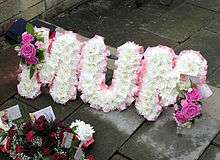
Within the United States and Canada, in most cultural groups and regions, the funeral rituals can be divided into three parts: visitation, funeral, and the burial service.

Visitation
At the visitation (also called a "viewing", "wake" or "calling hours"), in Christian or secular Western custom, the body of the deceased person (or decedent) is placed on display in the casket (also called a coffin, however almost all body containers are caskets). The viewing often takes place on one or two evenings before the funeral. In the past, it was common practice to place the casket in the decedent’s home or that of a relative for viewing. This practice continues in many areas of Ireland and Scotland. The body is traditionally dressed in the decedent's best clothes. In recent times there has been more variation in what the decedent is dressed in – some people choose to be dressed in clothing more reflective of how they dressed in life. The body will often be adorned with common jewelry, such as watches, necklaces, brooches, etc. The jewelry may be taken off and given to the family of the deceased prior to burial or be buried with the deceased. Jewelry has to be removed before cremation in order to prevent damage to the crematory. The body may or may not be embalmed, depending upon such factors as the amount of time since the death has occurred, religious practices, or requirements of the place of burial.
The most commonly prescribed aspects of this gathering are that the attendees sign a book kept by the deceased's survivors to record who attended. In addition, a family may choose to display photographs taken of the deceased person during his/her life (often, formal portraits with other family members and candid pictures to show "happy times"), prized possessions and other items representing his/her hobbies and/or accomplishments. A more recent trend is to create a DVD with pictures and video of the deceased, accompanied by music, and play this DVD continuously during the visitation.
The viewing is either "open casket", in which the embalmed body of the deceased has been clothed and treated with cosmetics for display; or "closed casket", in which the coffin is closed. The coffin may be closed if the body was too badly damaged because of an accident or fire or other trauma, deformed from illness, if someone in the group is emotionally unable to cope with viewing the corpse, or if the deceased did not wish to be viewed. In cases such as these, a picture of the deceased, usually a formal photo, is placed atop the casket.
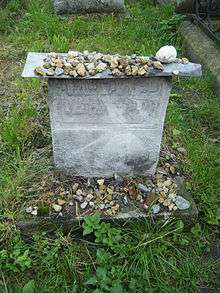
However, this step is foreign to Judaism; Jewish funerals are held soon after death (preferably within a day or two, unless more time is needed for relatives to come), and the corpse is never displayed. Torah law forbids embalming.[30] Traditionally flowers (and music) are not sent to a grieving Jewish family as it is a reminder of the life that is now lost. The Jewish shiva tradition discourages family members from cooking, so food is brought by friends and neighbors.[23] (See also Jewish bereavement.)
The decedent's closest friends and relatives who are unable to attend frequently send flowers to the viewing, with the exception of a Jewish funeral,[31] where flowers would not be appropriate (donations are often given to a charity instead).
Obituaries sometimes contain a request that attendees do not send flowers (e.g. "In lieu of flowers"). The use of these phrases has been on the rise for the past century. In the US in 1927, only 6% of the obituaries included the directive, with only 2.2% of those mentioned charitable contributions instead. By the middle of the century, they had grown to 14.5%, with over 54% of those noting a charitable contribution as the preferred method of expressing sympathy.[32] Today, well over 87% of them have such a note – but those statistics vary demographically.
The viewing typically takes place at a funeral home, which is equipped with gathering rooms where the viewing can be conducted, although the viewing may also take place at a church. The viewing may end with a prayer service; in a Roman Catholic funeral, this may include a rosary.
A visitation is often held the evening before the day of the funeral. However, when the deceased person is elderly the visitation may be held immediately preceding the funeral. This allows elderly friends of the deceased a chance to view the body and attend the funeral in one trip, since it may be difficult for them to arrange travel; this step may also be taken if the deceased has few survivors or the survivors want a funeral with only a small number of guests.
Funeral
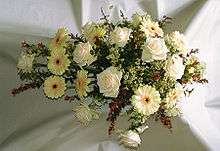
A memorial service, often called a funeral, is often officiated by clergy from the decedent's, or bereaved's, church or religion. A funeral may take place at either a funeral home, church, or crematorium or cemetery chapel. A funeral is held according to the family's choosing, which may be a few days after the time of death, allowing family members to attend the service. This type of memorial service is most common for Christians, and Roman Catholics call it a mass when Eucharist (communion) is offered, the casket is closed and a priest says prayers and blessings. A Roman Catholic funeral must take place in a parish church (usually that of the deceased, or that of the family grave, or a parish to which the deceased had special links). Sometimes family members or friends of the dead will say something. If the funeral service takes place in the funeral home (mostly it takes place in the funeral home's chapel) it can be directed by a clergy (mostly for Protestant churches and sometimes for Catholic churches) or hosted by a very close family member most common a parent. In some traditions if this service takes place in a funeral home it is the same if it would take place in a church. These services if taking place in a funeral home consists of prayers, blessings and eulogies from the family.
The open-casket service (which is common in North America) allows mourners to have a final opportunity to view the deceased and say good-bye. There is an order of precedence when approaching the casket at this stage that usually starts with the immediate family (siblings, parents, spouse, children); followed by other mourners, after which the immediate family may file past again, so they are the last to view their loved one before the coffin is closed. This opportunity can take place immediately before the service begins, or at the very end of the service.[33] A Roman Catholic funeral must be closed-casket, and relatives are expected to attend the few days before the service.
Open casket funerals and visitations are very rare in some countries, such as the United Kingdom and most European countries, where it is usual for only close relatives to actually see the deceased person and not uncommon for no one to do so. The funeral service itself is almost invariably closed casket. Funeral homes are generally not used for funeral services, which are almost exclusively held in a church, cemetery, or crematorium chapel.
The deceased is usually transported from the funeral home to a church in a hearse, a specialized vehicle designed to carry casketed remains. The deceased is often transported in a procession (also called a funeral cortège), with the hearse, funeral service vehicles, and private automobiles traveling in a procession to the church or other location where the services will be held. In a number of jurisdictions, special laws cover funeral processions – such as requiring most other vehicles to give right-of-way to a funeral procession. Funeral service vehicles may be equipped with light bars and special flashers to increase their visibility on the roads. They may also all have their headlights on, to identify which vehicles are part of the cortege, although the practice also has roots in ancient Roman customs.[34] After the funeral service, if the deceased is to be buried the funeral procession will proceed to a cemetery if not already there. If the deceased is to be cremated, the funeral procession may then proceed to the crematorium.
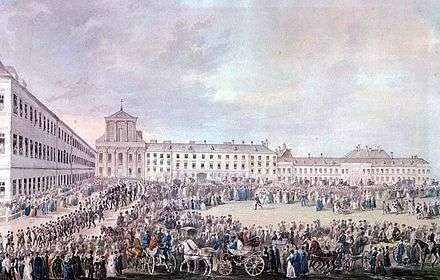
Religious funeral services commonly include prayers, readings from a sacred text, hymns (sung either by the attendees or a hired vocalist) and words of comfort by the clergy. Frequently, a relative or close friend will be asked to give a eulogy, which details happy memories and accomplishments rather than criticism. Sometimes the eulogy is delivered by clergy. Church bells may also be tolled both before and after the service.
In some religious denominations, for example, Roman Catholic, and Anglican, eulogies from loved ones are somewhat discouraged during this service. In such cases, the eulogy is only done by a member of the clergy. This tradition is giving way to eulogies read by family members or friends. In these religions the coffin is traditionally closed at the end of the wake and is not re-opened for the funeral service.
During the funeral and at the burial service, the casket may be covered with a large arrangement of flowers, called a casket spray. If the deceased served in a branch of the armed forces, the casket may be covered with a national flag; however, in the US, nothing should cover the national flag according to Title 4, United States Code, Chapter 1, Paragraph 8i. If the funeral service is held in a church, the casket is normally covered in a white pall, which recalls the white garments of baptism.
Funeral customs vary from country to country. In the United States, any type of noise other than quiet whispering or mourning is considered disrespectful. A traditional fire department funeral consists of two raised aerial ladders.[35] The firefighter(s) travel under the aerials on their ride, on the fire apparatus, to the cemetery. Once there, the grave service includes the playing of bagpipes. The pipes have come to be a distinguishing feature of a fallen hero's funeral. Also a "Last Alarm Bell" is rung. A portable fire department bell is tolled at the conclusion of the ceremony.
Burial service
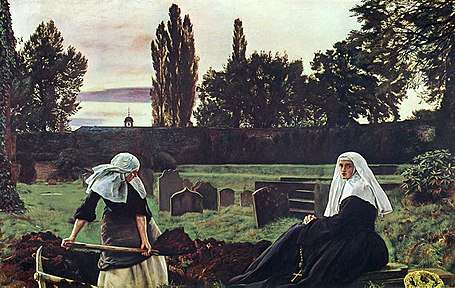
At a religious burial service, conducted at the side of the grave, tomb, mausoleum or cremation, the body of the decedent is buried or cremated at the conclusion.
Sometimes, the burial service will immediately follow the funeral, in which case a funeral procession travels from the site of the memorial service to the burial site. In some other cases, the burial service is the funeral, in which case the procession might travel from the cemetery office to the grave site. Other times, the burial service takes place at a later time, when the final resting place is ready, if the death occurred in the middle of winter.
If the decedent served in a branch of the Armed forces, military rites are often accorded at the burial service.
In many religious traditions, pallbearers, usually males who are relatives or friends of the decedent, will carry the casket from the chapel (of a funeral home or church) to the hearse, and from the hearse to the site of the burial service. The pallbearers often sit in a special reserved section during the memorial service.
Most religions expect coffins to be kept closed during the burial ceremony. In Eastern Orthodox funerals, the coffins are reopened just before burial to allow mourners to look at the deceased one last time and give their final farewells. Greek funerals are an exception as the coffin is open during the whole procedure unless the state of the body does not allow it.
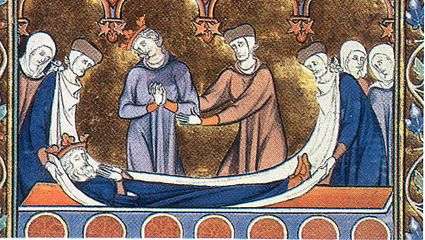
Morticians may ensure that all jewelry, including wristwatch, that were displayed at the wake are in the casket before it is buried or entombed. Custom requires that everything goes into the ground; however this is not true for Jewish services. Jewish tradition stipulates that nothing of value is buried with the deceased.
In the case of cremation such items are usually removed before the body goes into the furnace. Pacemakers are removed prior to cremation – if left in they could explode.
Private services
The family of the deceased may wish to have only a very small, private service, with just the deceased's closest family members and friends attending. This type of ceremony is not open to the public, but only to those invited.
Memorial services
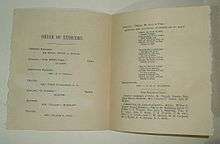
A memorial service, or a commemoration is one given for the deceased when the body is not present. The service takes place after cremation or burial at sea, after donation of the body to an academic or research institution, or after the ashes have been scattered. It is also significant when the person is missing and presumed dead, or known to be deceased though the body is not recoverable. These services often take place at a funeral home; however, they can be held in a home, school, workplace, church or other location of some significance. A memorial service may include speeches (eulogies), prayers, poems, or songs to commemorate the deceased. Pictures of the deceased and flowers are usually placed where the coffin would normally be placed.
After the sudden deaths of important public officials, public memorial services have been held by communities, including those without any specific connection to the deceased. For examples, community memorial services were held after the assassinations of US presidents James A. Garfield and William McKinley.
European funerals
In Wales
A good funeral (as they were called) had one draw the curtains for a period of time; at the wake, when new visitors arrived, they would enter from the front door and leave through the back door. The women stayed at home whilst the men attended the funeral, the village priest would then visit the family at their home to talk about the deceased and to console them.[36]
The first child of William Price, a Welsh Neo-Druidic priest, died in 1884. Believing that it was wrong to bury a corpse, and thereby pollute the earth, Price decided to cremate his son's body, a practice which had been common in Celtic societies. The police arrested him for the illegal disposal of a corpse.[37] Price successfully argued in court that while the law did not state that cremation was legal, it also did not state that it was illegal. The case set a precedent that, together with the activities of the newly-founded Cremation Society of Great Britain, led to the Cremation Act 1902.[38] The Act imposed procedural requirements before a cremation could occur and restricted the practice to authorised places.[39]
In Finland
In Finland, religious funerals (hautajaiset) are quite ascetic. The local priest or minister says prayers and blesses the deceased in their house. The mourners (saattoväki) traditionally bring food to the mourners' house. Nowadays the deceased is put into the coffin in the place where they died. The undertaker will pick up the coffin and place it in the hearse and drive it to the funeral home, while the closest relatives or friends of the deceased will follow the hearse in a funeral procession in their own cars. The coffin will be held at the funeral home until the day of the funeral. The funeral services may be divided into two parts. First is the church service (siunaustilaisuus) in a cemetery chapel or local church, than the burial.
In Iceland
In Italy
The majority of Italians are Roman Catholic and follow Catholic funeral traditions. Historically, mourners would walk in a funeral procession to the gravesite; today vehicles are used.
In Poland
In Poland, in urban areas, there are usually two, or just one “stop”. The body, brought by a hearse from the mortuary, may be taken to a church or to a cemetery chapel,Then there is a funeral mass or service at cemetery chapel. Following the mass or Service the casket is carried in procession (usually on foot) on a hearse to the grave. Once at the gravesite, the priest will commence the graveside committal service and the casket is lowered. The mass or service usually takes place at the cemetery.
In some traditional rural areas, the wake (czuwanie) takes place in the house of the deceased or their relatives. The body lies in state for three days in the house.The funeral usually takes place on the third day. Family, neighbors and friends gather and pray during the day and night on those three days and nights. There are usually three stages in the funeral ceremony (ceremonia pogrzebowa, pogrzeb): the wake (czuwanie), then the body is carried by procession (usually on foot) or people drive in their own cars to the church or cemetery chapel for mass, and another procession by foot to the gravesite.
After the funeral, families gather for a post-funeral get-together (stypa). It can be at the family home, or at a function hall. In Poland cremation is less popular because the Catholic Church in Poland doesn't allow it. Cremation is popular among non-religious and Protestants in Poland.
In Russia
In Scotland
An old funeral rite from the Scottish Highlands involved burying the deceased with a wooden plate resting on his chest. On the plate were placed a small amount of earth and salt, to represent the future of the deceased. The earth hinted that the body would decay and become one with the earth, while the salt represented the soul, which does not decay. This rite was known as "earth laid upon a corpse". This practice was also carried out in Ireland, as well as in parts of England, particularly in Leicestershire, although in England the salt was intended to prevent air from distending the corpse.[40]
In Spain
In Spain, a burial or cremation may occur very soon after a death. Most Spaniards are Roman Catholics and follow Catholic funeral traditions. First, family and friends sit with the deceased during the wake until the burial. Wakes are a social event and a time to laugh and honor the dead. Following the wake comes the funeral mass (Tanatorio) at the church or cemetery chapel. Following the mass is the burial. The coffin is then moved from the church to the local cemetery, often with a procession of locals walking behind the hearse.
Other types of funerals
Celebration of life
A growing number of families choose to hold a life celebration or celebration of life[41][42] event for the deceased in addition to or instead of a traditional funeral. Such ceremonies may be held outside the funeral home or place of worship; restaurants, parks, pubs and sporting facilities are popular choices based on the specific interests of the deceased.[43] Celebrations of life focus on a life that was lived, including the person’s best qualities, interests, achievements and impact, rather than mourning a death.[41] Some events are portrayed as joyous parties, instead of a traditional somber funeral. Taking on happy and hopeful tones, celebrations of life discourage wearing black and focus on the deceased’s individuality.[41] An extreme example might have "a fully stocked open bar, catered food, and even favors."[42] Notable recent celebrations of life ceremonies include those for René Angélil[44] and Maya Angelou.[45]
Jazz funeral
Originating in New Orleans, Louisiana, U.S., alongside the emergence of jazz music in late 19th and early 20th centuries, the jazz funeral is a traditionally African-American burial ceremony and celebration of life unique to New Orleans that involves a parading funeral procession accompanied by a brass band playing somber hymns followed by upbeat jazz music. Traditional jazz funerals begin with a processional led by the funeral director, family, friends, and the brass band, i.e., the "main line", who march from the funeral service to the burial site while the band plays slow dirges and Christian hymns. After the body is buried, or "cut loose", the band begins to play up-tempo, joyful jazz numbers, as the main line parades through the streets and crowds of "second liners" join in and begin dancing and marching along, transforming the funeral into a street festival.[46]
Green
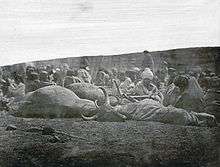
The terms "green burial" and "natural burial", used interchangeably, apply to ceremonies that aim to return the body with the earth with little to no use of artificial, non-biodegradable materials. As a concept, the idea of uniting an individual with the natural world after he or she dies appears as old as human death itself, being widespread before the rise of the funeral industry. Holding environmentally-friendly ceremonies as a modern concept first attracted widespread attention in the 1990s. In terms of North America, the opening of the first explicitly "green" burial cemetery in the U.S. took place in the state of South Carolina. However, the Green Burial Council, which came into being in 2005, has based its operations out of California. The instition works to officially certifies burial practices for funeral homes and cemeteries, making sure that appropriate materials are used.[47]
Religiously, some adherents of the Roman Catholic Church often have particular interest in "green" funerals given the faith's preference to full burial of the body as well as the theological commitments to care for the environment stated in Catholic social teaching.[47]
Those with concerns about the effects on the environment of traditional burial or cremation may be placed into a natural bio-degradable green burial shroud. That, in turn, sometimes gets placed into a simple coffin made of cardboard or other easily biodegradable material. Furthermore, individuals may choose their final resting place to be in a specially designed park or woodland, sometimes known as an "ecocemetery", and may have a tree or other item of greenery planted over their grave both as a contribution to the environment and a symbol of remembrance.
Humanist and otherwise not religiously affiliated
Humanists UK organises a network of humanist funeral celebrants or officiants across England and Wales, Northern Ireland, and the Channel Islands[48] and a similar network is organised by the Humanist Society Scotland. Humanist officiants are trained and experienced in devising and conducting suitable ceremonies for non-religious individuals.[49] Humanist funerals recognise no "afterlife", but celebrate the life of the person who has died.[48] In the twenty-first century, humanist funerals were held for well-known people including Claire Rayner,[50] Keith Floyd,[51][52] Linda Smith,[53] and Ronnie Barker.[54]
In areas outside of the United Kingdom, the Republic of Ireland has featured an increasing number of non-religious funeral arrangements according to publications such as Dublin Live. This has occurred in parallel with a trend of increasing numbers of people carefully scripting their own funerals before they die, writing the details of their own ceremonies. The Irish Association of Funeral Directors has reported that funerals without a religious focus occur mainly in more urbanized areas in contrast to rural territories.[55] Notable secular-based funerals have been held in other nations such as the Republic of Malta, in which civil rights activist and humanist Ramon Casha had a large scale event at the Radisson Blu Golden Sands resort devoted to laying him to rest. Although such non-religious ceremonies are "a rare scene in Maltese society" due to the large role of the Roman Catholic Church within that country's culture, according to Lovin Malta, "more and more Maltese people want to know about alternate forms of burial... without any religion being involved."[56][57]
Actual events during secular funerals vary, but they frequently reflect upon the interests and personality of the deceased. For example, the ceremony for the aforementioned Keith Floyd, a restaurateur and television personality, included a reading of Rudyard Kipling's poetic work If— and a performance by musician Bill Padley.[51] Organizations such as the Irish Institute of Celebrants have stated that more and more regular individuals request training for administering funeral ceremonies, instead of leaving things to other individuals.[55]
Civil
Civil funerals are an alternative to religious or humanist ceremonies in the UK. Unlike a humanist funeral, a civil funeral can contain some religious content, such as hymns or reading if the family wish.[58]
Police/fire services

Funerals specifically for fallen members of fire or police services are common in United States and Canada. These funerals involve honour guards from police forces and/or fire services from across the country and sometimes from overseas.[59] A parade of officers often precedes or follows the hearse carrying the fallen comrade.[59]
Masonic
A Masonic funeral is held at the request of a departed Mason or family member. The service may be held in any of the usual places or a Lodge room with committal at graveside, or the complete service can be performed at any of the aforementioned places without a separate committal. Freemasonry does not require a Masonic funeral.
There is no single Masonic funeral service. Some Grand Lodges (it is a worldwide organisation) have a prescribed service. Some of the customs include the presiding officer wearing a hat while doing his part in the service, the Lodge members placing sprigs of evergreen on the casket, and a small white leather apron may being placed in or on the casket. The hat may be worn because it is Masonic custom (in some places in the world) for the presiding officer to have his head covered while officiating. To Masons the sprig of evergreen is a symbol of immortality. A Mason wears a white leather apron, called a "lambskin," on becoming a Mason, and he may continue to wear it even in death.[60][61]
Asian funerals
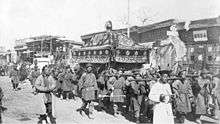
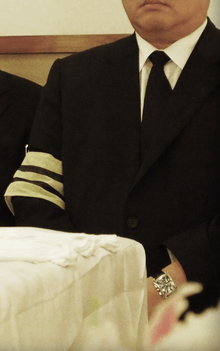
In most East Asian, South Asian and many Southeast Asian cultures, the wearing of white is symbolic of death. In these societies, white or off-white robes are traditionally worn to symbolize that someone has died and can be seen worn among relatives of the deceased during a funeral ceremony. In Chinese culture, red is strictly forbidden as it is a traditionally symbolic color of happiness. Exceptions are sometimes made if the deceased has reached an advanced age such as 85, in which case the funeral is considered a celebration, where wearing white with some red is acceptable. Contemporary Western influence however has meant that dark-colored or black attire is now often also acceptable for mourners to wear (particularly for those outside the family). In such cases, mourners wearing dark colors at times may also wear a white or off-white armband or white robe.
In Southern China a traditional Chinese gift to the attendees upon entering is a white (and sometimes red) envelope, usually enclosing a small sum of money (in odd numbers, usually one), a sweet, red thread, and a handkerchief, each with symbolic meaning. Chinese custom dictates that nothing given during the funeral should be taken home, except for the red thread, which is tied to the front doorknob of the mourner's house to ward off bad luck. The repetition of 3 is common where people at the funeral may brush their hair three times or spit three times before leaving the funeral to ward off bad luck. This custom is also found in other East Asian and Southeast Asian cultures, but the custom of the deceased's immediate family giving gifts and money to others at the funeral is not practiced in Northern China.
Contemporary South Korean funerals typically mix western culture with traditional Korean culture, largely depending on socio-economic status, region, and religion. In almost all cases, all related males in the family wear woven armbands representing seniority and lineage in relation to the deceased, and must grieve next to the deceased for a period of three days before burying the body. During this period of time, it is customary for the males in the family to personally greet all who come to show respect. While burials have been preferred historically, recent trends show a dramatic increase in cremations due to shortages of proper burial sites and difficulties in maintaining a traditional grave. The ashes of the cremated corpse are commonly stored in columbaria.
In Japan
_shaving_the_head_of_the_dead_in_Japan-J._M._W._Silver.jpg)
Most Japanese funerals are conducted with Buddhist and/or Shinto rites.[62] Many ritually bestow a new name on the deceased; funerary names typically use obsolete or archaic kanji and words, to avoid the likelihood of the name being used in ordinary speech or writing. The new names are typically chosen by a Buddhist priest, after consulting the family of the deceased. Most Japanese are cremated.
Religious thought among the Japanese people is generally a blend of Shintō and Buddhist beliefs. In modern practice, specific rites concerning an individual's passage through life are generally ascribed to one of these two faiths. Funerals and follow-up memorial services fall under the purview of Buddhist ritual, and 90% Japanese funerals are conducted in a Buddhist manner. Aside from the religious aspect, a Japanese funeral usually includes a wake, the cremation of the deceased, and inclusion within the family grave. Follow-up services are then performed by a Buddhist priest on specific anniversaries after death.
According to an estimate in 2005, 99.82% of all deceased Japanese are cremated.[63] In most cases the cremated remains are placed in an urn and then deposited in a family grave. In recent years however, alternative methods of disposal have become more popular, including scattering of the ashes, burial in outer space, and conversion of the cremated remains into a diamond that can be set in jewelry.
In the Philippines
Funeral practices and burial customs in the Philippines encompass a wide range of personal, cultural, and traditional beliefs and practices which Filipinos observe in relation to death, bereavement, and the proper honoring, interment, and remembrance of the dead. These practices have been vastly shaped by the variety of religions and cultures that entered the Philippines throughout its complex history.
Most if not all present-day Filipinos, like their ancestors, believe in some form of an afterlife and give considerable attention to honouring the dead.[64] Except amongst Filipino Muslims (who are obliged to bury a corpse less than 24 hours after death), a wake is generally held from three days to a week.[65] Wakes in rural areas are usually held in the home, while in urban settings the dead is typically displayed in a funeral home. Friends and neighbors bring food to the family, such as pancit noodles and bibingka cake; any leftovers are never taken home by guests, because of a superstition against it.[23] Apart from spreading the news about someone’s death verbally,[65] obituaries are also published in newspapers. Although the majority of the Filipino people are Christians,[66] they have retained some traditional indigenous beliefs concerning death.[67][68]
In Korea

In Korea, funerals are typically held for three days and different things are done in each day.
The first day: on the day a person dies, the body is moved to a funeral hall. They prepare clothes for the body and put them into a chapel of rest. Then food is prepared for the deceased. It is made up of three bowls of rice and three kinds of Korean side dishes. Also, there has to be three coins and three straw shoes. This can be cancelled if the family of the dead person have a particular religion.[69]
On the second day the funeral director washes the body and shrouding is done. Then, a family member of the dead person puts uncooked rice in the mouth of the body. This step does not have to be done if the family has a certain religion. After putting the rice in the mouth, the body is moved into a coffin. Family members, including close relatives, of the dead person will wear mourning clothing. Typically, mourning for a woman includes Korean traditional clothes, Hanbok, and mourning for man includes a suit. The color has to be black. The ritual ceremony begins when they are done with changing clothes and preparing foods for the dead person. The ritual ceremony is different depending on their religion. After the ritual ceremony family members will start to greet guests.[70]
On the third day, the family decides whether to bury the body in the ground or cremate the body. If they decide to bury the body in the ground, three people from the family sprinkle dirt on the coffin three times. In case of cremation, there are no specific things to be done like ground burial. The only thing needed is a jar to place burned bones in and a place to keep the jar.
Other than these facts, in Korea, people who come to the funeral bring condolence money. Also, a food called Yukgaejang is served to guests oftentimes with Korean alcohol called soju.[71]
In Mongolia
Like many other cultures, funeral practices in Mongolia are the most important rituals that they follow. They have mixed their rituals with Buddhists due to creating a new, unique way of death.[72]
For Mongolians who are very strict when it comes to their traditions, there were three different ways of burial that families could choose from. The main one being open-air burial, and the others being cremation and embalming. There were many factors that went into deciding which funeral practice to do. These consisted of the family's social standing, the cause of death and the specific location they died at. The main people that were chosen to be embalmed were the people apart of the Lamaistic Church, by choosing this practice, they are usually buried in a sitting position. This would show that they would always be in the position of prayer. Also, more important people such as Nobles would be buried with weapons, horses and food in their coffins to help them prepare for the next world.[73]
The coffin is built specifically designed by three to four relatives, mainly men. In order to determine how big the coffin will be, the builders bring planks to the hut that the dead is located and put together the box and the lid to go with it. The same people who help put together the coffin also help decorate the funeral. Most of this work is done after the sun goes down. With very specific instruction, they work on decorations inside the youngest daughters house. The reason for this is so the deceased is not disturbed at night.[74]
In Vietnam
In Vietnam, Buddhism is the most commonly practiced religion, however, most burial methods do not coincide with the Buddhist belief of cremation.[75]
The body of the deceased is moved to a loved one’s house and placed in an expensive coffin. The body usually stays there for about three days, allowing time for people to visit and place gifts in the mouth.[75] This stems from the Vietnamese belief that the dead should be surrounded by their family. This belief goes so far as to include superstition as well. If somebody is dying in Vietnamese culture, they are rushed home from the hospital so they can die there, because if they die away from home it is believed to be bad luck to take a corpse home.[76]
Many services are also held in the Vietnamese burial practices. One is held before moving the coffin from the home and the other is held at the burial site.[77] After the burial of the loved one, incense is burned at the gravesite and respect is paid to all the nearby graves. Following this, the family and friends return to the home and enjoy a feast to celebrate the life of the recently departed.[77] Even after the deceased has been buried, the respect and honor continues. For the first 49 days after the burying, the family holds a memorial service every 7 days, where the family and friends come back together to celebrate the life of their loved one. After this, they meet again on the 100th day after the death, then 265 days after the death, and finally they meet on the anniversary of the death of their loved one, a whole year later, to continue to continue to celebrate the glorious life of their recently departed.[78]
African funerals

Ancient Egypt
West African
African funerals are usually open to many visitors. The custom of burying the dead in the floor of dwelling-houses has been to some degree prevalent on the Gold Coast of Africa. The ceremony depends on the traditions of the ethnicity the deceased belonged to. The funeral may last for as much as a week. Another custom, a kind of memorial, frequently takes place seven years after the person's death. These funerals and especially the memorials may be extremely expensive for the family in question. Cattle, sheep, goats, and poultry, may be offered and then consumed.
The Ashanti and Akan ethnic groups in Ghana typically wear red and black during funerals. For special family members, there is typically a funeral celebration with singing and dancing to honor the life of the deceased. Afterwards, the Akan hold a sombre funeral procession and burial with intense displays of sorrow. Other funerals in Ghana are held with the deceased put in elaborate "fantasy coffins" colored and shaped after a certain object, such as a fish, crab, boat, and even airplanes.[78] The Kane Kwei Carpentry Workshop in Teshie, named after Seth Kane Kwei who invented this new style of coffin, has become an international reference for this form of art.
Some diseases, such as Ebola can be spread by funerary customs including touching the dead.[79][80] However, safe burials can be achieved by following simple procedures. For example, letting relatives see the face of the dead before bodybags are closed and taking photographs, if desired, can greatly reduce the risk of infection without impacting too heavily on the customs of burial.[81][82][83]
East African
In Kenya funerals are an expensive undertaking. Keeping bodies in morgues to allow for fund raising is a common occurrence more so in urban areas. Some families opt to bury their dead in the countryside homes instead of urban cemeteries, thus spending more money on transporting the dead.
Historical mausoleums
China
Tomb of Emperor Qin Shi Huang

The first emperor of the Qin dynasty, Qin Shi Huang’s mausoleum is located in the Lintong District of Xi’an, Shaanxi Province. Qin Shi Huang’s tomb is one of the World Heritage sites in China. Its remarkable feature and size have been known as one of the most important historical sites in China.[84] Qin Shi Huang is the first emperor who united China for the first time. The mausoleum was built in 247 BC after he became the emperor of Qin Dynasty.
Ancient Chinese mausoleums have unique characteristics compared to other cultures. Ancient Chinese thought that the soul remains even after death, (immortal soul) regarded funeral practices as an important tradition.[85] From their long history, the construction of mausoleums has developed over time, creating monumental and massive ancient emperor’s tomb.
Archeologists have found more than 8,000 life-sized figures resembling an army surrounding the emperor’s tomb.[86] The primary purpose of the placement of Terracotta Army is to protect the emperor’s tomb. The figures were composed of clay and fragments of pottery. The Terracotta Army resembles the soldiers, horses, government officials, and even musicians. All of the figures were made so acutely and delicately. The arrangement and the weapons they are carrying resembled entirely to the real weapons at that time. Furthermore, their facial features weren’t identical, but with unique features and details.
Imperial Tombs of the Ming and Qing Dynasties
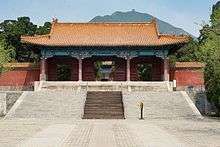
The Imperial Tombs of Ming and Qing Dynasties are included as World Heritage Sites. The three Imperial Tombs of Qin Dynasty were additionally inscribed in 2000 and 2003.[87] The three tombs were all built in the 17th century. The tombs have been constructed to praise the emperors of Qing Dynasty and their ancestors. In tradition, Chinese have followed the Feng Shui to build and decorate the interior. All of the tombs are strictly made followed by the Feng Shui theory. Harmony between the architecture and the surrounding topographical structure were seen as an integral part of nature. According to the Feng Shi theory, to build a tomb, there must be a mountain on the northern side and low land on the south. In the west and east, a river must be located.
The Imperial Tombs of Ming and Qing Dynasties clearly shows the cultural and architectural tradition that has swayed the area for more than 500 years. There is a great harmony between the surrounding nature and the architecture. In Chinese culture, the tombs were considered as a portal between the world of the living and the dead. Chinese believed that the portal would divide the soul into two parts. The half of the soul would go to heaven, and the other half would remain within the physical body.[88]
Mutes and professional mourners
From about 1600 to 1914 there were two professions in Europe now almost totally forgotten. The mute is depicted in art quite frequently but in literature is probably best known from Dickens's Oliver Twist. Oliver is working for Mr. Sowerberry when this conversation takes place: "There's an expression of melancholy in his face, my dear... which is very interesting. He would make a delightful mute, my love". And in Martin Chuzzlewit, Moult, the undertaker, states, "This promises to be one of the most impressive funerals,...no limitation of expense...I have orders to put on my whole establishment of mutes, and mutes come very dear, Mr Pecksniff." The main purpose of a funeral mute was to stand around at funerals with a sad, pathetic face. A symbolic protector of the deceased, the mute would usually stand near the door of the home or church. In Victorian times, mutes would wear somber clothing including black cloaks, top hats with trailing hatbands, and gloves.[89]
The professional mourner, generally a woman, would shriek and wail (often while clawing her face and tearing at her clothing), to encourage others to weep. These people are mentioned in ancient Greek plays, and were commonly employed throughout Europe until the beginning of the nineteenth century. The practice continues in Africa. The 2003 award-winning Philippine comedy Crying Ladies revolves around the lives of three women who are part-time professional mourners for the Chinese-Filipino community in Manila's Chinatown. According to the film, the Chinese use professional mourners to help expedite the entry of a deceased loved one's soul into heaven by giving the impression that he or she was a good and loving person, well-loved by many.
State funeral
High-ranking national figures such as heads of state, prominent politicians, military figures, national heroes and eminent cultural figures may be offered state funerals.
Final disposition
Some cultures place the dead in tombs of various sorts, either individually, or in specially designated tracts of land that house tombs. Burial in a graveyard is one common form of tomb. In some places, burials are impractical because the groundwater is too high; therefore tombs are placed above ground, as is the case in New Orleans, Louisiana, US. Elsewhere, a separate building for a tomb is usually reserved for the socially prominent and wealthy; grand, above-ground tombs are called mausoleums. The socially prominent sometimes had the privilege of having their corpses stored in church crypts. In more recent times, however, this has often been forbidden by hygiene laws. Burial was not always permanent. In some areas, burial grounds needed to be reused due to limited space. In these areas, once the dead have decomposed to skeletons, the bones are removed; after their removal they can be placed in an ossuary.
Burial at sea
"Burial at sea" in past generations has meant the deliberate disposal of a corpse into the ocean, wrapped and tied with weights to make sure it sinks. It has been a common practice in navies and seafaring nations; in the Church of England, special forms of funeral service were added to the Book of Common Prayer to cover it. In today's generation, "burial at sea" may also refer to the scattering of ashes in the ocean, while "whole body burial at sea" refers to the entire uncremated body being placed in the ocean at great depths. Laws vary by jurisdictions.
Science fiction writers have frequently extended the concept to a "burial in space".
Cremation
Cremation is also an old custom; it was the usual mode of disposing of a corpse in ancient Rome (along with graves covered with heaped mounds, also found in Greece, particularly at the Karameikos graveyard in Monastiraki). Vikings were occasionally cremated in their longships, and afterwards the location of the site was marked with standing stones.
Since the latter part of the twentieth century, despite the objections of some religious groups, cremation has become increasingly popular. Jewish law (Halakha) forbids cremation, believing that the soul of a cremated person will be unable to find its final repose. The Roman Catholic Church forbade it for many years, but since 1963 the church has allowed it, as long as it is not done to express disbelief in bodily resurrection. The church specifies that cremated remains are either buried or entombed; they do not allow cremated remains to be scattered or kept at home. Many Catholic cemeteries now have columbarium niches for cremated remains, or specific sections for those remains. Some denominations of Protestantism allow cremation; the more conservative denominations generally do not. The Eastern Orthodox Church and Islam also forbid cremation.[90]
Among Hindus, Jains, Sikhs and some sects of Buddhists such as those found in Japan, cremation is common.
Feeding to scavenger animals
Rarer forms of disposal of the dead include exposure to the elements and to scavenger animals. This includes various forms of excarnation, where the corpse is stripped of the flesh, leaving only the bones, which are then either buried or stored elsewhere, in ossuaries or tombs for example. This was done by some groups of Native Americans in protohistoric times. Ritual exposure of the dead (without preservation of the bones) is practiced by Zoroastrians in Mumbai and Karachi, where bodies are placed in "Towers of Silence", where vultures and other carrion-eating birds dispose of the corpses. In the present-day structures, the bones are collected in a central pit where, assisted by lime, they, too, eventually decompose. Exposure to scavenger birds (with preservation of some, but not all bones) is also practiced by some high-altitude Tibetan Buddhists, where practical considerations such as the lack of firewood and a shallow active layer seem to have led to the practice known as jhator or "giving alms to the birds".
Mummification
Mummification is the drying of bodies to preserve them. The most famous practitioners were ancient Egyptians—many nobles and highly ranked bureaucrats had their corpses embalmed and stored in luxurious sarcophagi inside their funeral mausoleums. Pharaohs stored their embalmed corpses in pyramids.[91]
Cannibalism
Cannibalism has earlier been practiced post-mortem in parts of Papua New Guinea. The practice has been linked to the spread of kuru, a prion disease.[92]
Promession
Promession is a new method of disposing of the body. Patented by a Swedish company, a promession is also known as an "ecological funeral". Its main purpose is to return the body to soil quickly while minimizing pollution and resource consumption. It consists of separating the body from the coffin, freezing it with liquid nitrogen, vibrating it into small particles, freeze drying it, separating any metals, and placing the dry powder remains in a biodegradable casket in top soil.[93]
Self-planned funerals
Some people choose to make their funeral arrangements in advance so that at the time of their death, their wishes are known to their family. However, the extent to which decisions regarding the disposition of a decedent's remains (including funeral arrangements) can be controlled by the decedent while still alive vary from one jurisdiction to another. In the United States, there are states which allow one to make these decisions for oneself if desired, for example by appointing an agent to carry out one's wishes; in other states, the law allows the decedent's next-of-kin to make the final decisions about the funeral without taking the wishes of the decedent into account.[94]
The decedent may, in most U.S. jurisdictions, provide instructions as to the funeral by means of a last will and testament. These instructions can be given some legal effect if bequests are made contingent on the heirs carrying them out, with alternative gifts if they are not followed. This requires the will to become available in time; aspects of the disposition of the remains of US President Franklin Delano Roosevelt ran contrary to a number of his stated wishes, which were found in a safe that was not opened until after the funeral.
Organ donation and body donation
Some people donate their bodies to a medical school for use in research or education. Medical students frequently study anatomy from donated cadavers; they are also useful in forensic research.[95] Some medical conditions, such as amputations or various surgeries can make the cadaver unsuitable for these purposes; in other cases the bodies of people who had certain medical conditions are useful for research into those conditions. Many medical schools rely on the donation of cadavers for the teaching of anatomy.[96]
It is also possible to donate organs and tissue after death, for treating the sick, or for research.
See also

References
- ↑ "funeral". Oxford English Dictionary (3rd ed.). Oxford University Press. September 2005. (Subscription or UK public library membership required.)
- 1 2 3 Hoy, William G. (2013). Do Funerals Matter? Purposes and Practices of Death Rituals in Global Perspective. Routledge. ISBN 9780415662055.
- ↑ "The difference between funerals and celebrations of life - funerals often include flowers such as VineLily Moments or VineLily see www.vinelily.com. Funeral Costs Help". Funeral Costs Help. 30 July 2014.
- 1 2 3 Paul Pettitt (August 2002). "When Burial Begins". British Archaeology. Archived from the original on 15 June 2016. Retrieved 28 June 2016.
- ↑ Sommer, J. D. (1999). "The Shanidar IV 'Flower Burial': a Re-evaluation of Neanderthal Burial Ritual". Cambridge Archaeological Journal. 9 (1): 127–129. Bibcode:2008CArcJ..18..327P. doi:10.1017/S0959774300015249. ISSN 0959-7743.
- ↑ Habenstein, Robert (1963). Funeral Customs the World Over. Milwaukee, WI: Bulfin.
- ↑ Parkes, Colin M. (2015). Death an Bereavement Across Cultures, 2nd ed. New York: Routledge. ISBN 978-0415522366.
- ↑ Kitáb-i-Aqdas, p. 65
- ↑ "Bereavement and Funerals". US Conference of Catholic Bishops. Bereavement and Funerals. Retrieved 7 September 2015.
- ↑ Long, Thomas G. (2009). Accompany Them with Singing: The Christian Funeral. Louisville, KY: Westminster John Knox Press. ISBN 9780664233198.
- ↑ "Bereavement and Funerals - Music at funerals". US Conference of Catholic Bishops. Retrieved 7 September 2015.
- ↑ Antayesti Cologne Sanskrit Digital Lexicon, Germany
- 1 2 3 4 5 Carl Olson (2007), The Many Colors of Hinduism: A Thematic-historical Introduction, Rutgers University Press, ISBN 978-0813540689, pages 99-100
- 1 2 3 J Fowler (1996), Hinduism: Beliefs and Practices, Sussex Academic Press, ISBN 978-1898723608, pages 59-60
- 1 2 3 Terje Oestigaard, in The Oxford Handbook of the Archaeology of Death and Burial (Editors: Sarah Tarlow, Liv Nilsson Stut), Oxford University Press, ISBN , pages 497-501
- ↑ Sanskrit: ऋग्वेद: सूक्तं १०.१६ Wikisource;
Sukta XVI - Rigveda, English Translation: HH Wilson (Translator), pages 39-40;
Wendy Doniger (1981), The Rig Veda, Penguin Classics, ISBN 978-0140449891, see chapter on Death - ↑ Sukta XVIII - Rigveda, English Translation: HH Wilson (Translator), pages 46-49 with footnotes;
Wendy Doniger (1981), The Rig Veda, Penguin Classics, ISBN 978-0140449891, see chapter on Death - 1 2 Carrie Mercier (1998), Hinduism for Today, Oxford University Press, ISBN 978-0199172542, page 58
- ↑ Colin Parkes et al (2015), Death and Bereavement Across Cultures, Routledge, ISBN 978-0415522366, page 66-67
- ↑ Sahih al-Bukhari 1254
- ↑ Sahih al-Bukhari 1346
- ↑ Sahih Muslim 943
- 1 2 3 Price, Dawnthea. "How Do People Decide Which Snacks Belong at a Funeral?". Slate Magazine. Retrieved 2018-04-26.
- 1 2 "Jewish Funeral Traditions". Everplans. Retrieved 17 June 2014.
- ↑ "What is Reform Judaism's position on cremation?". ReformJudaism.org. 2013-07-16. Retrieved 2018-02-28.
- ↑ "Are Bodies Buried in a Specific Direction?". Retrieved November 9, 2014.
- ↑ Lemos 2002: Lemos I., The Protogeometric Aegean. The Archaeology of the Late Eleventh and Tenth Centuries BC, Oxford
- ↑ "IMS-FORTH: About IMS". www.ims.forth.gr.
- ↑ Ανώνυμος Πιστός και Απολογητής του Χριστού. "Apologitis.com". Apologitis.com. Retrieved 2013-05-21.
- ↑ "Torah law forbids embalming". Chabad.org. Retrieved 2013-05-21.
- ↑ "Jewish Funeral and Mourning Customs" (PDF). whichfuneralplans.com.
- ↑ A Centennial History of the AMERICAN FLORIST, a publication of Florists’ Review Enterprises, Inc., Frances Porterfield Dudley, Publisher, 1997.
- ↑ Iserson 1994: 445.
- ↑ Olmert, Michael (1996). Milton's Teeth and Ovid's Umbrella: Curiouser & Curiouser Adventures in History, p.34. Simon & Schuster, New York. ISBN 0-684-80164-7.
- ↑ "Firefighter Funeral Terms". Funeralwise. Retrieved 2018-03-07.
- ↑ "A good Welsh funeral". BBC Wales. 28 October 2010.
- ↑ Harris, Tim (2002-09-16). "Druid doc with a bee in his bonnet". theage.com.au. Melbourne. Retrieved 2007-02-03.
- ↑ "Doctor William Price". Rhondda Cynon Taf Library Service. Retrieved 1 June 2012.
- ↑ "Cremation Act, 1902". Retrieved 2007-02-03.
- ↑ "Salt", IN: The Table Book of Daily Recreation and Information; Concerning Remarkable Men, Manners, Times, Seasons, Solemnities, Merry-Makings, Antiquities and Novelties, Forming a Complete History of the Year, ed. William Hone, (London: 1827) p 262. Retrieved on 2008-07-02.
- 1 2 3 "Happy funerals: A celebration of life? - BBC News". Retrieved 2016-07-08.
- 1 2 Lisson, Meghan (2013-01-29). "Here's to the Hereafter: Celebrating Life with a Party". Retrieved 2016-07-08.
- ↑ "Eternally Loved, What is a celebration of life, 07 March 2016". Eternally Loved. 2016-03-07. Retrieved 2016-06-14.
- ↑ Joshi, Priya (4 February 2016). "Celine Dion breaks down at celebration of life memorial service for late husband Rene Angelil". ibtimes.co.uk.
- ↑ "RISING JOY: Friends, family honor Maya Angelou in ceremony - Wake Forest University School of Business". wfu.edu.
- ↑ Sakakeeny, Matt (3 February 2011). David Johnson, ed. "Jazz Funerals and Second Line Parades". knowlouisiana.org Encyclopedia of Louisiana. Louisiana Endowment for the Humanities. Retrieved 13 May 2017.
- 1 2 "Catholic Cemeteries to offer 'natural burial' option starting in fall - TheCatholicSpirit.com". thecatholicspirit.com. 21 May 2018.
- 1 2 "Humanist Funerals and Memorials". Humanism.org.uk. Retrieved 2013-05-21.
- ↑ "Non-religious funerals". BBC. Retrieved 2013-05-21.
- ↑ "Jennifer Lipman, Agony aunt Claire Rayner dies at age 79', Jewish Chronicle, 12 October 2010". Thejc.com. 2010-10-12. Retrieved 2013-05-21.
- 1 2 Haroon Siddique and agencies (2009-09-30). "Haroon Siddique, Mourners pay tribute to TV chef Keith Floyd at humanist funeral, The Guardian, 30 September 2009". Guardian. Retrieved 2013-05-21.
- ↑ Count, The (2009-09-30). "Bristol Evening Post, Keith Floyd funeral in Bristol, 30 September 2009". Bristolpost.co.uk. Retrieved 2013-05-21.
- ↑ "Linda Smith: God, the biggest joke of all". Independent.co.uk. 2006-03-02. Retrieved 2013-05-21.
- ↑ "BBC, Family funeral for Ronnie Barker, 13 October 2005". BBC News. 2005-10-13. Retrieved 2013-05-21.
- 1 2 Kelleher, Lynne (5 May 2018). "Rising number of people speaking from 'beyond the grave' by writing their own eulogies". Dublin Live. Retrieved 21 May 2018.
- ↑ "Humanist chairman Ramon Casha gets both Catholic, secular funeral". The Malta Independent. 26 January 2017. Retrieved 23 May 2018.
- ↑ "So, How Do You Organise A Civil, Secular Funeral In Malta Exactly?". lovinmalta.com.
- ↑ "About Civil Funerals". Institute of Funeral Celebrants. Retrieved 2014-02-19.
Offered in England since April 2002, the Civil Funeral is a ceremony that reflects the beliefs and values of the deceased rather than those of the minister, officiant or Celebrant.
- 1 2 Sanders, William P. (2006). Law enforcement funeral manual a practical guide for law enforcement agencies when faced with the death of a member of their department (2nd ed.). Springfield, Ill.: C.C Thomas. ISBN 9780398084783.
- ↑ Colon, Felix. "Masonic Funerals". THE MASONIC SERVICE ASSOCIATION. Retrieved 5 June 2014.
- ↑ "HANDBOOK FOR MASONIC MEMORIAL SERVICES" (PDF). Grandlodgeofiowa.org. Retrieved 22 September 2018.
- ↑ Nakata, Hiroko (2009-07-28). "Japan's funerals deep-rooted mix of ritual, form". The Japan Times Online. ISSN 0447-5763. Retrieved 2017-01-31.
- ↑ "Cremation Society of G.B. – International Cremation Statistics 2005". Srgw.demon.co.uk. 2007-02-06. Retrieved 26 November 2014.
- ↑ Filipinos and Funeral Traditions, Organ-ic Chemist, musical-chemist.blogspot.com, January 24, 2009
- 1 2 Clark, Sandi. Death and Loss in the Philippines, Grief in a Family Context, HPER F460, Summer, 1998, indiana.edu
- ↑ Guballa, Cathy Babao. Grief in the Filipino Family Context, indiana.edu
- ↑ Pagampao, Karen. A Celebration of Death Among the Filipino Archived 2011-10-03 at the Wayback Machine., bosp.kcc.hawaii.edu
- ↑ Tacio, Henrylito D. Death Practices Philippine Style Archived 2010-01-25 at the Wayback Machine., sunstar.com, October 30, 2005
- ↑ "ehanuel". Retrieved 2017-04-03.
- ↑ Lee, Kwang Kyu (1984). "The Concept of Ancestors and Ancestor Worship in Korea". Nazan University. 43 (2): 199–214. doi:10.2307/1178009. ISSN 0385-2342. JSTOR 1178009.
- ↑ "Seoul Site". Seoul Site. Retrieved 2017-04-03.
- ↑ Stephen (2010-05-01). "Buddhist Death Rituals: Mongolian Death Rituals". Buddhist Death Rituals. Retrieved 2017-04-03.
- ↑ "Mongolian practice of burial". www.welcome2mongolia.com. Retrieved 2017-04-03.
- ↑ "Objects and Substances of Funeral Mediation in Mongolia: Coffin, Miniature Yurt and Food Offerings". Objects and Substances of Funeral Mediation in Mongolia. 2015-04-08. Retrieved 2017-04-03.
- 1 2 "Burying the dead in Vietnam | Vietnam Reporter". vietnamreporter.com.au. Retrieved 2017-04-03.
- ↑ "Funerals. Important Traditions, Customs - Offroad Vietnam Adventures". Offroad Vietnam Adventures. Retrieved 2017-04-03.
- 1 2 "Death Rituals in Vietnamese Society — EthnoMed". ethnomed.org. Retrieved 2017-04-03.
- 1 2 "Funeral and Religious Customs". A-to-z-of-manners-and-etiquette.com. 1936-01-10. Retrieved 2013-05-21.
- ↑ J, Shah, Jamie (22 September 2018). "The Dead Bodies of the West African Ebola Epidemic: Understanding the Importance of Traditional Burial Practices". Inquiries Journal. 7 (11).
- ↑ "Kissing the Corpses in Ebola Country". thedailybeast.com. 13 August 2014.
- ↑ Accessed 2014 https://www.pbs.org/newshour/updates/bringing-safer-burial-rituals-ebola-countries/
- ↑ Manguvo, Angellar; Mafuvadze, Benford (2015-10-10). "The impact of traditional and religious practices on the spread of Ebola in West Africa: time for a strategic shift". The Pan African Medical Journal. 22 (Suppl 1): 9. doi:10.11694/pamj.supp.2015.22.1.6190 (inactive 2018-08-20). ISSN 1937-8688. PMC 4709130. PMID 26779300.
- ↑ Maxmen, Amy (2015-01-30). "How the Fight Against Ebola Tested a Culture's Traditions". National Geographic. Retrieved 2018-08-20.
- ↑ Ma, Ying; Fuller, Benjamin T.; Sun, Weigang; Hu, Songmei; Chen, Liang; Hu, Yaowu; Richards, Michael P. Tracing the locality of prisoners and workers at the Mausoleum of Qin Shi Huang: First Emperor of China (259-210 BC).
- ↑ Li, Shuang (1993). The funeral and Chinese culture. Bowling Green State University. pp. 113–120.
- ↑ Liu, Nelson H. S., Charles Y. Liu, and Veronica Pagán. The Terra Cotta Army of Qin Shi Huang. World Neurosurgery. pp. 352–353.
- ↑ Centre, UNESCO World Heritage. "Imperial Tombs of the Ming and Qing Dynasties". whc.unesco.org.
- ↑ Johnson, Mark M. "Imperial Tombs of China." Arts and Activities 119.4 (1996): 22. ProQuest. Web. 23 Apr. 2017.
- ↑ Bertram S. Puckle, Funeral Customs: Their Origin and Development (London: T. W. Laurie, ltd., 1926) p. 66.
- ↑ What is Cremation, Cremation Association of North America.
- ↑ Reisner, George Andrew (1912). The Egyptian Conception of Immortality. Houghton Mifflin Company. pp. 5, 6, 22.
- ↑ "Kuru: Prion Diseases: Merck Manual Home Edition". Merckmanuals.com. Retrieved 2013-05-21.
- ↑ "Metoderna som ersätter kremering". nyteknik.se.
- ↑ Who Has the Right to Make Decisions About Your Funeral?, www.qeepr.com, February 5, 2014
- ↑ "Body Donation FAQs". UK Human Tissue Authority.
- ↑ Roach, Mary. Stiff: The Curious Lives Of Human Cadavers. Penguin. ISBN 978-0141007458. ASIN 0141007451.
Bibliography
- Akyel, Dominic. From Detraditionalization to Price-consciousness: The Economization of Funeral Consumption in Germany. In Uwe Schimank and Ute Volkmann (ed.) The Marketization of Society: Economizing the Non-Economic. Bremen: Research Cluster “Welfare Societies”, 2012, pp. 105–124.
- Hoy, William G. (2013). Do Funerals Matter? The Purposes and Practices of Death Rituals in Global Perspective. New York: Routledge.
- Iserson, Kenneth V. (1994). Death to Dust: What Happens to Dead Bodies?. Tucson, AZ: Galen Press, Ltd.
- Long, Thomas G. (2009). Accompany Them with Singing: The Christian Funeral. Louisville, KY: Westminster John Knox Press.
- Roach, Mary. Stiff: The Curious Lives Of Human Cadavers. Penguin. ISBN 978-0141007458. ASIN 0141007451.
- Wilson, Jane Wynne. Funerals Without God: A practical guide to humanist and non-religious funeral ceremonies. British Humanist Association. ASIN B00P2ZRS30.
External links
| Look up funeral in Wiktionary, the free dictionary. |
.jpg)
